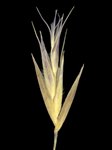
T. karijini spikelet.

T. karijini habitat.

T. karijini orifice and hairy sheath.
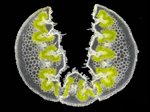
T. karijini leaf section.
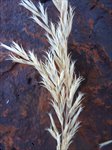
T. karijini inflorescence.
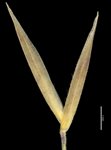
T. karijini glumes.
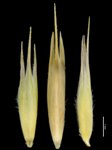
T. karijini lemmas.
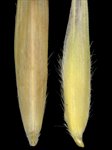
T. karijini lemma bases.
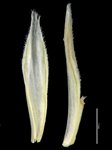
T. karijini paleas.

T. karijini map.
Name
Triodia karijini M.D.Barrett, ined.
Citation
Nuytsia, in press, (2017).
Derivation
karijini — from Karijini, meaning ‘hilly place’ in the local Banyjima language, in reference to both the habitat on hills, and the nearby Karijini National Park; used as a noun in apposition.Common name
Pilbara Mountain Spinifex
Synonyms
Triodia sp. Karijini (S. van Leeuwen 4111)Diagnostic features
Foliage non-resinous to weakly resinous; leaf sheath surfaces hairy or not; leaf blades epistomatous (soft-type), 19–33.5 cm long; lower glume 3–6.3 mm long, L:W 5–7.8, 3–5-nerved; lowest lemma 3–lobed to shortly awned, the lobes narrowly triangular with or without a short ±terete awn, lemma body uniformly textured, with hairs arranged in longitudinal rows; lowest lemma midlobe 2.0–3.0 mm long; palea glabrous, not or scarcely winged; only known from ironstone ridges above 900 m on mountains in the eastern Hamersley range.
Habitat
Occurs on or near outcropping ironstone, on summits or steep hillslopes of mountains.
Distribution and frequency
Endemic to the eastern Hamersley Range. Only known rfrom three locations, all above 900 m, on summits or steep slopes of mountains in the central Hamersley range, from near Mt Mossenson on the eastern edge of the Karijini National Park to Mt Robinson. The total known range is 43 km. Populations can be dense but are patchy and restricted to mountain tops and sides.
Similar species
Triodia karijini belongs to the Soft group, sharing the epistomatous (soft-type) leaf blades. Three other Pilbara species in the Soft Group (T. veniciae, T. melvillei and T. pisoliticola) share the combination of narrowly lanceolate glumes and uniformly textured (not bitextured) lemmas.
Triodia veniciae is the most similar species morphologically, sharing the narrowly triangular to sub-awned lemmas lobes 2–3.2 mm long and hairy leaf sheath surfaces. Triodia veniciae is copiously resinous (non-resinous to weakly resinous in T. karijini), and palea with hairs restricted to central zone (palea glabrous in T. karijini), and 7–14 spikelets on longest basal panicle branches (3–6 spikelets in T. karijini). Triodia karijini is only known from above 900 m on ironstone ridges on mountains in the Hamersley Range, while T. veniciae is only known from shale slopes in the Chichester range north of the Fortescue River.
The closest genetic relative of T. karijini is T. pisoliticola, which shares the narrowly lanceolate glumes and non-resinous, epistomatous leaves, but occurs disjunctly in the western Hamersley Range. Triodia karijini differs from T. pisoliticola in having narrowly triangular to sub-awned lemma lobes (distinctly awned in T. pisoliticola) and generally shorter leaves 19–34 cm long (24–59 cm long in T. pisoliticola).
Triodia melvillei occurs within the range of T. karijini, but can be distinguished by having prominently awned lemmas with midlobe 10–14 mm long (acute to sub-awned with midlobe 2.0–3.0 mm long in T. karijini), and resinous foliage (non-resinous in T. karijini). Triodia melvillei also usually occurs on red loam flats, and only rarely on rock on high mountains.
Conservation status
Priority One.
Identification without florets
The non-resinous to weakly resinousfoliage and epistomatous (soft) leaves, combined with central-Hamersley Range distribution and mountain habit are diagnostic. All four of the other species with epistomatous (soft-type) leaves in the eastern Hamersley Range (T. biflora, T. melvillei, T. pungens and T. sp. Mt Ella) have copiously resinous foliage. Triodia biflora and T. pungens also have glumes with L:W<4 (L:W 5–6.8 in T. karijini). Triodia sp. Mt Ella has glabrous sheath surfaces (but often ciliate margins), while T. karijini has sparsely to moderately densely hairy sheath surfaces and glabrous margins.
Variation
A fairly uniform species, but differs in the degree of resin on the foliage, from none to traces in lines along the leaf blades.
Notes
Specimens of Triodia karijini were not represented in Lazarides (1997), Lazarides et al. (2005) or Ausgrass (Sharp & Simon, 2002; Simon & Alonso, 2014).
A full description of T. karijini can be found in Barrett (2017b).
Does not occur in an area that stock can readily access.